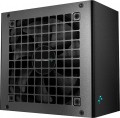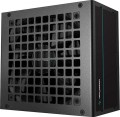Power
The output power of the power supply, in other words, is the maximum power that it is capable of delivering to the system. For the computer to operate efficiently, the power supply must be greater than the total power consumption of the system at maximum load. The latter can be calculated by summing the power of individual components, however, in general, for office configurations
, about 400 W —
450 W is considered sufficient, for medium gaming — about
600 W(
500 W,
550 W,
650 W,
700 W,
750 W), and for the top ones —
power of 800 W and above (
850 W,
1000 W and even
more than 1 kW).
Certification
The presence or absence of an 80+ certificate for the power supply. This certificate indicates high energy efficiency: to obtain it, the efficiency (see above) must be at least 80%, and in different modes (20%, 50% and 100% of the maximum load). There are several degrees of 80+:
—
80+. The original version of the certificate, assuming an efficiency of at least 82% (at least 85% for 50% load).
—
80+ White. The second name of the original 80+ certificate (see above).
—
80+ Bronze — efficiency not less than 85% (for half load — 88%).
—
80+ Silver — respectively 87% (90% for half load).
—
80+ Gold — 89% (92% for half load)
—
80+ Platinum — 90% (94% for half load).
—
80+ Titanium — 94% (96% for half load).
The power factor (see "PFC Type") must be at least 0.9 for the lower levels and at least 0.95 for the Platinum level. Also note that for redundant power used in server systems, the efficiency requirements are somewhat lower.
MB/CPU power supply
The number and type of connectors provided in the PSU to power the motherboard or processor.
This parameter is written as the sum of several numbers, for example, "24+4". The first number in such an entry means the number of contacts in the connector for powering the motherboard; in the vast majority of cases, this is just 24, since modern motherboards use a 24-pin connector as standard. The second number describes the socket for powering the processor; most entry-level and mid-range CPUs use 4-pin power, but powerful chips may require 8-pin power. There can be several 4- or 8-pin connectors — based on powerful high consumption processors.
A separate case is the blocks of the "24 (20 + 4)" format. They have two separate plugs — 20 pin and 4 pin, which allows you to power both 24-pin motherboards and older 20-pin motherboards from such power supplies. At the same time, such models do not provide a separate power supply for CPU — it is powered only through the socket, and the 4-pin plug cannot be connected to any other components except the motherboard.
Now on the market there are PSUs with such power supply for the motherboard:
24 pin (20+4),
24+4 pin,
24+8(4+4) pin,
24+8+8(4+4) pin.
MOLEX
The number of Molex (IDE) connectors provided in the design of the power supply.
Initially, such a connector was intended to power peripherals for the IDE interface, primarily hard drives. And although the IDE itself is completely obsolete today and is not used in new components, however, the Molex power connector continues to be installed in power supplies, and almost without fail. Almost any modern PSU has at least
1 – 2 of these connectors, and in high-end models this number can be
7 or more. This situation is due to the fact that Molex IDE is a fairly universal standard, and with the help of the simplest adapters, components with a different power interface can be powered from it. For example, there are Molex - SATA adapters for drives, Molex - 6 pin for video cards, etc.
+3.3V
The maximum values of current and power that the PSU can provide on individual power lines.
The power line can be simply described as a pair of contacts for connecting a particular load; one of these contacts is “ground” (with zero voltage), and the second has a certain voltage with a plus or minus sign, this voltage corresponds to the voltage of the power line. In this paragraph, it is + 3.3V (such power is present in 20- and 24-pin connectors for motherboards, in SATA power connectors and some other types of connectors).
In general, power and currents are rather specific parameters that the average user rarely needs — mainly when connecting high-power components such as video cards, as well as when starting a PSU without a computer to power other electronics (for example, amateur radio stations). It is also worth mentioning that the sum of the maximum powers on all lines can be higher than the total output power of the PSU — this means that all lines cannot operate at full power at the same time. Accordingly, when the PSU is fully loaded, some of them will produce less power than the maximum possible.
+5V
The maximum current that the PSU is capable of issuing + 5V to the power line. For more information about power lines in general, see "+3.3V". Also note here that + 5V power, in addition to connectors for motherboards (for 20 and 24 pins), is also found in Molex and SATA plugs, as well as some other specific types of connectors.
+12V1
The maximum current that the PSU is capable of delivering to the first power line is + 12V.
For more information about power lines in general, see "+3.3V". Here it is worth mentioning that 12 V is the most popular voltage among computer power connectors. It is used in almost all such connectors (with a few exceptions), and some plugs (for example, additional PCI-E power for 6 or 8 connectors) use only 12-volt lines — and in the + 12V format. And the division of + 12V power into several separate lines is used for safety purposes — in order to reduce the current flowing through each individual wire, and thus prevent excessive load and overheating of the wiring. However, some manufacturers do not specify the maximum current for individual + 12V lines and give only a general value in the characteristics; in such cases, this number is indicated in this paragraph.
+12V
The maximum power that the PSU is capable of delivering to the + 12V power line.
See "Maximum current and power" for details on power lines in general. Here it is worth mentioning that 12 V is the most popular voltage among computer power connectors. It is used in almost all such connectors (with a few exceptions), and some plugs (for example, additional PCI-E power for 6 or 8 connectors) use only 12-volt lines — and in the + 12V format. So this indicator is one of the most important characteristics of any PSU.
Note that many power supplies have several separate + 12V power lines. In such cases, the total power is indicated here, which, usually, is divided equally between the lines.
Protection
Protection circuits provided in the power supply. In addition to the OVP (overvoltage protection), OPP (overcurrent/power protection), and SCP (short circuit protection) described above, modern PSUs may include the following safety features:
— O.C.P. Overload protection on individual power outputs. It differs from OPP in that it takes into account not the total current consumption, but the current at each output separately.
— UVP. Undervoltage protection at the output of the power supply. For some components, such a voltage is as undesirable as an increased voltage: for example, a hard drive at reduced power cannot spin the plates to the required speeds. Usually, UVP is activated when the voltage drops by 20 – 25%.
— OTP. Protection against overheating of individual components of the power supply.
— SIP. Protection against voltage surges and surges is, in fact, a built-in stabilizer that can smooth out these surges to a certain extent. This feature does not eliminate the need for an external stabilizer, but it improves the overall performance of the protection.
— A.F.C. Not so much a protective as an “energy saving” function: automatic fan speed control, which allows you to change the speed depending on the load and the actual heat dissipation of the PSU. In addition to saving energy, this adjustment also reduces wear on the moving parts of the cooler.
— C.E. Power supply complies with European Union dire...ctives for energy efficiency and safety.
— CB. Power supply complies with IEC (International Electrotechnical Commission) directives regarding the safety of electrical equipment and components.
— FCC. Power supply complies with FCC (Federal Communications Commission) directives, especially regarding electromagnetic interference.
— CCC. Compliance of the power supply with the requirements necessary for official certification in the Chinese market (PRC).
— K.C. Compliance of the power supply with the requirements necessary for official certification in the South Korean market.
— BSMI. Compliance of the power supply with the requirements required for official certification in the Taiwan market.
— RCM. Power supply meets the requirements for official certification in the Australian and New Zealand market. RCM requirements are primarily concerned with safe use and electromagnetic compatibility.
— TUV-RH. Power supply meets the criteria for certification by TÜV Rheinland Group, one of the world's largest and most respected auditing and certification companies. Most often, we are talking about the TÜV-Mark Approval certificate, which indicates that the individual parts of the device (body, boards, parts, switches, etc.) comply with the requirements for safe use.
— cTUVus. Another certification held by the above mentioned TÜV Rheinland Group. In this case, we are talking about the compliance of the power supply with the technical requirements necessary for admission to the markets of the USA and Canada. The cTUVus certificate has the same legal validity as certificates issued directly by the authorities in those countries.
— EAC. Compliance of the power supply with the technical requirements of the Eurasian Economic Union (former Customs Union).

